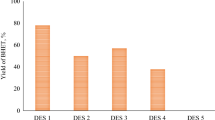Abstract
The glycolysis of poly(ethylene terephthalate) (PET) by diethyleneglycol (DEG) in the presence of acetate catalyst usually produces a dark color product. Various catalysts have been used, but only ZnSO4·7H2O gives a bright yellowish liquid material. In addition, after the reaction the catalyst ZnSO4·7H2O can be separated easily and reused. Under microwave irradiation, the PET glycolysis is more efficient in time, conversion, and color improvement. The reaction mixture was purified by treatment with 20% sodium chloride solution. The structure of the isolated products was confirmed by FTIR, NMR, and HPLC-MS. Condensate of the volatile material from the glycolysis reaction was also isolated and analyzed by GC-MS. The mechanisms of PET degradation by DEG and side product formation were proposed. The transesterification of PET with excess DEG was strongly competed by the degradation of DEG to form dioxane and acetaldehyde as main volatile side products and by ether formation; therefore, the using of excessive DEG was unfavorable for the PET glycolysis.







Similar content being viewed by others
References
Pardal F, Tersac G (2006) Comparative reactivity of glycols in PET glycolysis. Polym Degrad Stab 9:2567–2578. https://doi.org/10.1016/j.polymdegradstab.2006.05.016
Patel MR, Patel JV, Mishra D, Sinha VK (2007) Synthesis and characterization of low volatile content polyurethane dispersion from depolymerised polyethylene terephthalate. J Polym Environ 15:97–105. https://doi.org/10.1007/s10924-007-0050-y
Cakic SM, Ristic IS, Cincovic MM, Nikolic NC, Ilic OZ, Stojiljkovic DT, Bsimendic JK (2012) Glycolyzed products from PET waste and their application in synthesis of polyurethane dispersions. Prog Org Coat 74:115–124. https://doi.org/10.1016/j.porgcoat.2011.11.024
Halacheva N, Novakov P (1995) Preparation of oligoester diols by alcoholytic destruction of poly(ethylene terephthalate). Polymer 36:867–874. https://doi.org/10.1016/0032-3861(95)93119-7
Karayannidis GP, Achilias DS, Sideridou ID, Bikiaris DN (2005) Alkyd resins derived from glycolized waste poly(ethylene terephthalate). Eur Polym J 41:201–210. https://doi.org/10.1016/j.eurpolymj.2004.10.001
Colomines G, VanderLee A, Robin JJ, Boutevin B (2008) X-ray diffraction of the crystallinity of glycolysates derived from PET. Eur Polym J 44:2874–2885. https://doi.org/10.1016/j.eurpolymj.2008.07.008
Essawy HA, Tawfik ME, Elsayed NH (2012) Effect of addition of glycolysis products of poly(ethyleneterephthalate) wastes to urea-formaldehyde resin on its adhesion performance to wood substrates and formaldehyde emission. J Appl Polym Sci 123:2377–2383. https://doi.org/10.1002/app.34750
Luo X, Li Y (2014) Synthesis and characterization of polyols and polyurethane foams from PET waste and crude glycerol. J Polym Environ 22:318–328. https://doi.org/10.1007/s10924-014-0649-8
Achilias DS, Redhwi HH, Siddiqui MN, Nikolaidis AK, Bikiaris DN, Karayannidis GP (2010) Glycolytic depolymerization of PET waste in a microwave reactor. J Appl Polym Sci 118:3066–3073. https://doi.org/10.1002/app.32737
Aiemsa-art C, Phanwiroj P, Potiyaraj P (2011) Thermal and morphological properties of polyurethane foams prepared from microwave-assisted glycolyzed products of PET bottles wastes. Energy Procedia 9:428–434. https://doi.org/10.1016/j.egypro.2011.09.047
Roy PK, Mathur R, Kumar D, Rajagopal C (2013) Tertiary recycling of poly(ethylene terephthalate) wastes for production of polyurethane–polyisocyanurate foams. J Environ Chem Eng 1:1062–1069. https://doi.org/10.1016/j.jece.2013.08.019
Zhang W, Shi X, Zhang X, Han C, Zhang D (2012) PET depolymerization catalyzed by sulfates under microwave irradiation. Adv Mat Res 550–553:792–797. https://doi.org/10.4028/www.scientific.net/AMR.550-553.792
Acknowledgements
This research is funded by Vietnam National University HoChiMinh City (VNU-HCM) under Grant Number 562-2018-18-02.
Author information
Authors and Affiliations
Corresponding authors
Rights and permissions
About this article
Cite this article
Hoang, C.N., Le, T.T.N. & Hoang, Q.D. Glycolysis of poly(ethylene terephthalate) waste with diethyleneglycol under microwave irradiation and ZnSO4·7H2O catalyst. Polym. Bull. 76, 23–34 (2019). https://doi.org/10.1007/s00289-018-2369-z
Received:
Revised:
Accepted:
Published:
Issue Date:
DOI: https://doi.org/10.1007/s00289-018-2369-z




